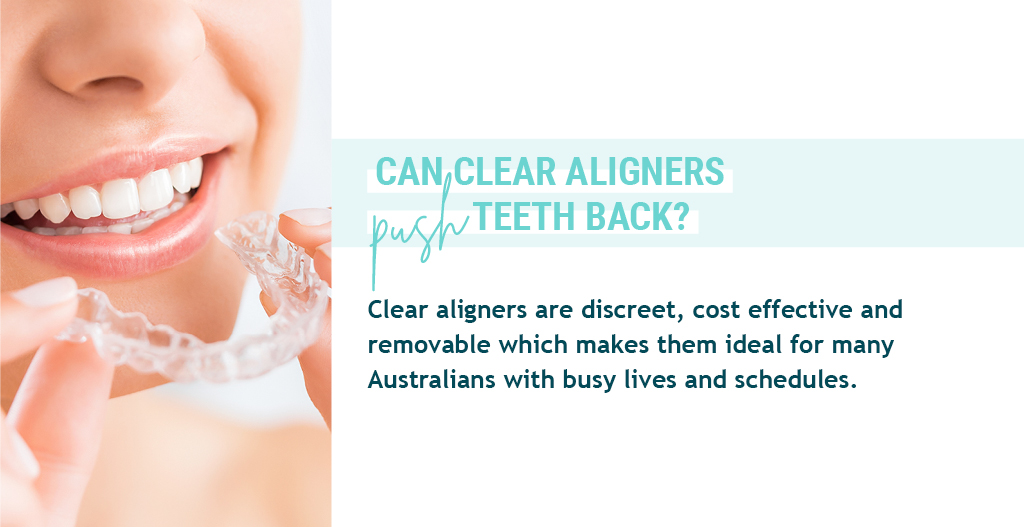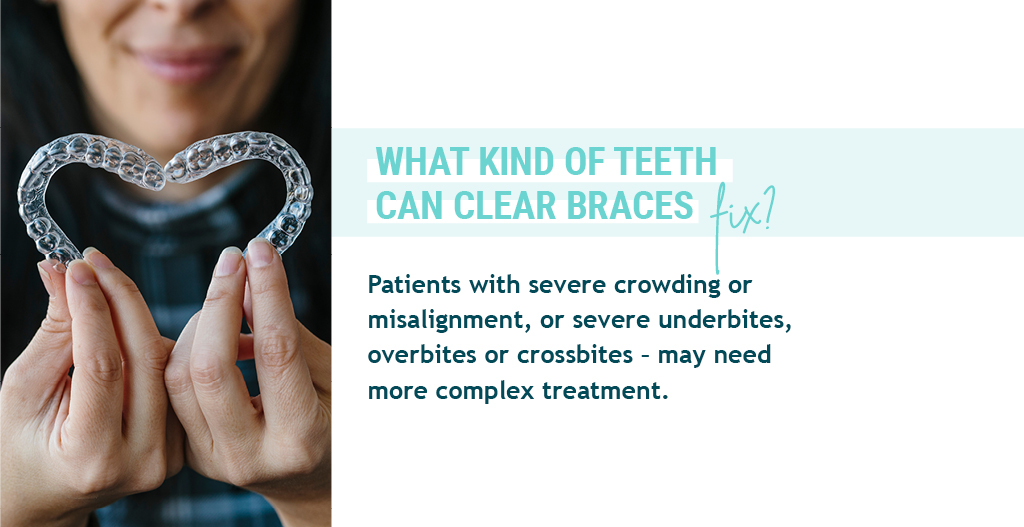Can clear aligners push teeth back? Can you even straighten teeth without braces? Will clear aligners work for my teeth? These are often the questions that people ask themselves and their dentist when considering clear aligners as a teeth straightening treatment option. Clear aligners are becoming a popular option in Australia – and we can see why!
Aligners are clear plastic trays that are moulded to your teeth and work by gently applying pressure until your smile reaches your desired end result. Clear aligners are a great, cost effective option for anyone with mild to moderate misalignment and who is looking for a straighter smile!
In this blog we explore how clear aligners work, your teeth alignment options, and the issues that can be corrected using clear aligners. We’ll also explore the factors that might mean that clear aligners aren’t the best option for you.

Can Clear Aligners Push Teeth Back?
Clear aligners are a great option to consider when exploring teeth straightening treatments. They’re discreet, cost effective and removable which makes them ideal for many Australians with busy lives and schedules. But how do they work? Can clear aligners push teeth back? Absolutely! Depending on the severity of your teeth misalignment or crookedness, clear aligners will most likely be able to help push those pesky out-of-place teeth right to where they’re meant to be.
When undergoing clear aligner treatment you’ll receive multiple sets of top and bottom aligners and the amount of each will depend on your personal treatment plan. You’ll need to move to the next set of aligners every 2 weeks or so, or once they start to feel a bit loose. Aligners work by applying gentle pressure to those out of place teeth to guide them into the desired position. The treatment shouldn’t be painful, however slight tenderness when changing to a new set is normal.
Your Options for Teeth Alignment
Braces
Braces are traditionally the most popular teeth straightening treatment option in Australia, and are especially great for children and adolescents or those with severe misalignment or crowding. Braces work by applying constant pressure to your teeth to slowly move them into the desired position. Generally, braces are metal brackets attached to the teeth and connected with a metal wire. As the pressure takes effect, the bone in the jaw changes to allow the teeth and their roots to move.
Ceramic Braces
Ceramic braces are essentially the same as traditional metal braces, however they are either tooth-coloured or clear brackets designed to blend into your teeth. Many people opt for ceramic braces because they’re less noticeable than metal braces and you are able to choose your colour for the most seamless blend possible.
Lingual Braces
Lingual braces have the same components as traditional braces, but they’re fixed to the back of your teeth (the lingual side) – meaning that they’re nearly invisible. Overall, lingual braces can correct the same types of alignment issues that traditional braces can, although they aren’t suitable for everybody. For example, patients with deep overbites may experience issues with the brackets popping off more frequently.
Clear Aligners
Similar to braces, clear aligners apply small amounts of pressure to your teeth to move them into their final position. Multiple sets of clear aligners are required and each set moves the teeth in increments until the desired movement is achieved and you’ll be ready for your next set.
Can You Straighten Teeth Without Braces?
Recent technological advances have meant that teeth straightening treatments no longer need to be lengthy, unsightly and inconvenient as traditional braces are for many. The good news is, there are plenty of great options available in the market currently for those who are considering straightening their teeth but are deterred by one or more features commonly associated with traditional metal braces.
While there are a number of treatment options similar to metal braces, clear aligners are one of the more popular alternative options for a multitude of reasons. Although clear aligners work essentially the same as traditional braces by gently guiding your teeth into the desired position –clear aligners work far more discreetly and they’re also removable meaning that you can easily take them out for any important events.
In short, yes – you absolutely can straighten your teeth without braces! However, if you’re still wondering “can aligners push teeth back”, it may be best to get a consultation to find out what clear aligners can do for your personal situation.
How Can Aligners Push Teeth Back?
So, how can aligners push teeth back? Clear aligners work through applying gentle pressure to your teeth to move them into a new position. Each set of aligners is a unique 3D-printed model of the teeth designed to move them into different positions throughout the straightening process until the desired end result is achieved.
When pressure is applied to a tooth through the clear aligners, the periodontal ligament surrounding it is stretched on one side of the root and compressed on the other. You may experience some minor inflammation, but the good news is that this is just the body’s initial attempt to heal, and during this process two kinds of bone cells are produced: osteoclasts and osteoblasts. Osteoclasts break down existing bone on the compressed side of the periodontal ligament, while osteoblasts build new bone on the stretched side.
Multiple sets of aligners will be required during your treatment and you’ll move from one set to the next generally every 2 weeks, or when the clear aligners begin to feel loose. When asking “can aligners push teeth back?” it’s important to understand that with each new set of aligners your teeth will move closer and closer until your desired end result is achieved – it won’t be an overnight result.

What Kind of Teeth Can Clear Braces Fix?
What kind of teeth can clear braces fix? Unfortunately, clear aligners aren’t the best option for everyone and are typically used for patients with mild to moderate teeth crowding, or have minor spacing issues. Patients with severe crowding or misalignment, or severe underbites, overbites or crossbites – may need more complex treatment which is generally better suited to traditional braces.
As clear aligners are custom built for a tight fit and are a unique 3D model of your teeth, they are better suited to adults and adolescents. Straightening a child’s teeth is more complicated as their mouths are still growing and developing and so braces are traditionally a better option.
Clear aligners can be used to treat a number of different issues including – an underbite, overbite, crooked teeth, crossbite, gaps in teeth, open bite, and crowded teeth. The number of aligner sets that you require will depend on the severity of your misalignment or spacing whereas milder cases will require less sets and will have a shorter overall treatment time.
More severe issues that are still able to be treated with clear aligners will generally involve more sets of aligners, require face to face treatment from a dentist or orthodontist, and will have a longer treatment time. Can aligners push teeth back? Yes! However, it is best to have a consultation so you can see what result clear aligners can deliver for you.
Can Teeth be Too Crooked for Clear Braces?
Can teeth be too crooked for clear braces? Unfortunately yes, in some cases teeth can be too crooked to be treated by clear aligners. Clear aligners do not have the same force and capabilities to move teeth as braces, despite the nearly identical treatment method. There are number of different situations where clear aligners may not be the most practical teeth straightening option, including:
Tooth shape
Some patients have teeth that aren’t ideal for fitting inside the aligner such as short, round, pegged teeth or those with severe tips may not allow the aligner to get a good grip.
Tooth position
When the mouth is overcrowded, a tooth may rotate to fit. If the rotation is over 20 degrees for molars, clear aligners will be unable to move them into the desired position.
Large gaps
Clear aligners can only reliably close up 6mm of space per arch (top teeth or lower teeth) and so severe spacing between teeth may be better treated using traditional braces.
Previous dental work
Some prior dental work can exclude patients from using clear aligners as a treatment option. A dental bridge can make it impossible to fit the aligners, and porcelain veneers or crowns may also be an issue.
Can Teeth be Too Crooked for EZ SMILE?
When researching “can aligners push teeth back?”, you may come across a number of at home clear aligner companies. One of these is EZ SMILE – a 100% Australian owned clear aligner company with the entire treatment able to be completed from home. EZ SMILE treatments are unfortunately still subject to the above mentioned limitations. At-home treatments with clear aligners are a great option for those with mild to moderate misalignment or crowding, and may not be able to treat more complex issues. However, one of the great benefits of this kind of treatment is being able to complete it from home.
The first part of this process is to complete a FREE 30-second online assessment to find out if EZ SMILE is right for you. This questionnaire will serve as an initial indication of whether or not you can be treated using clear aligners and is simply a set of “yes” or “no” questions. This screening process will check if you have previously been treated with crowns, veneers, bridges, implants, dentures or if you have any missing teeth – and answering yes to any of these questions may indicate that clear aligners aren’t the best option for you.
If you’re an initial candidate for EZ SMILE, you will be given the option to either purchase an impression kit or book a FREE 3D scan at one of the 14 locations across Australia. Unfortunately, some teeth can be too crooked to treat using EZ SMILE, and clear aligners in general, however the online assessment is a great tool for an initial indication of whether or not clear aligners are a suitable treatment option for you. EZ SMILE also provides a 100% money back guarantee if they can not treat you.

